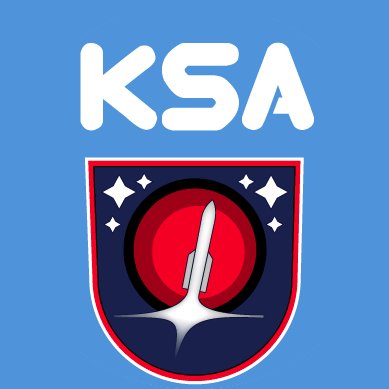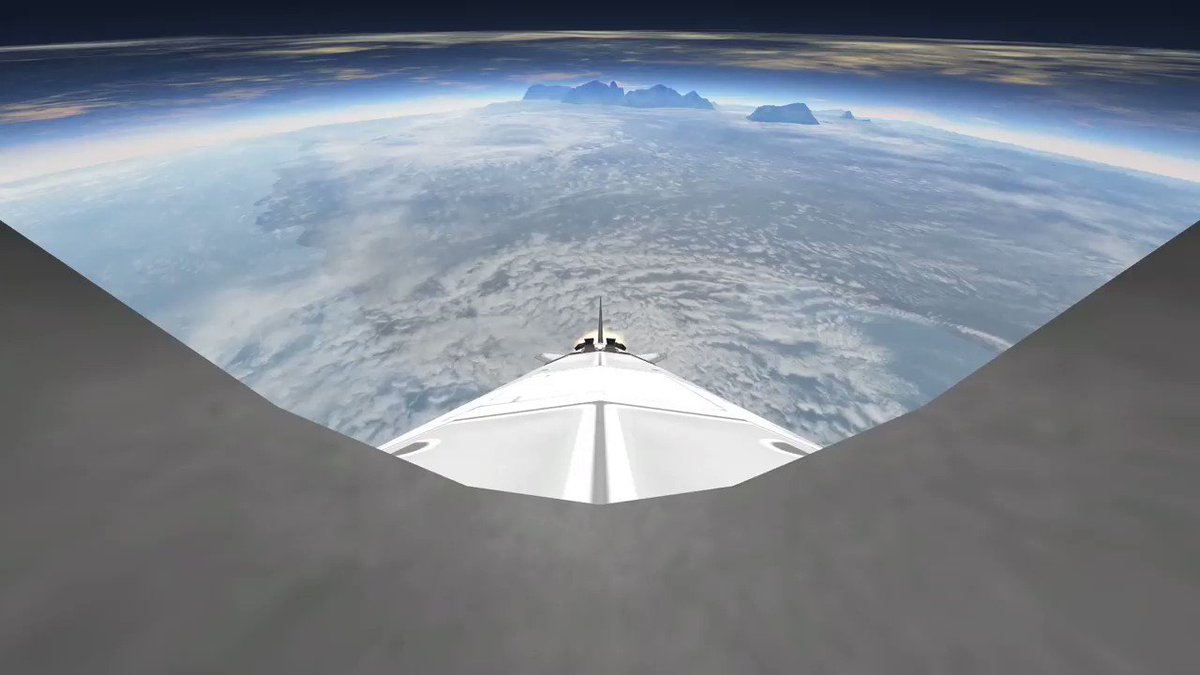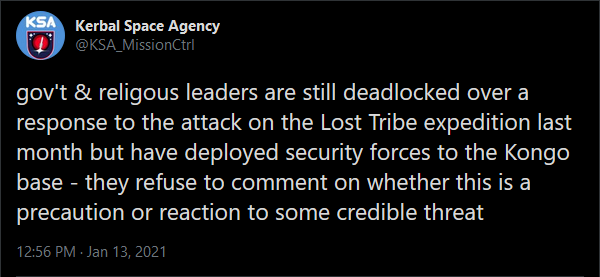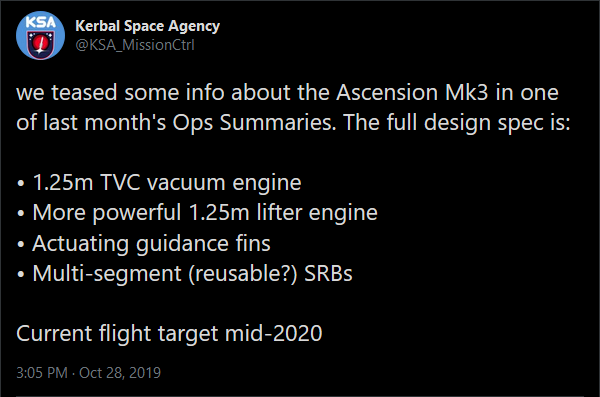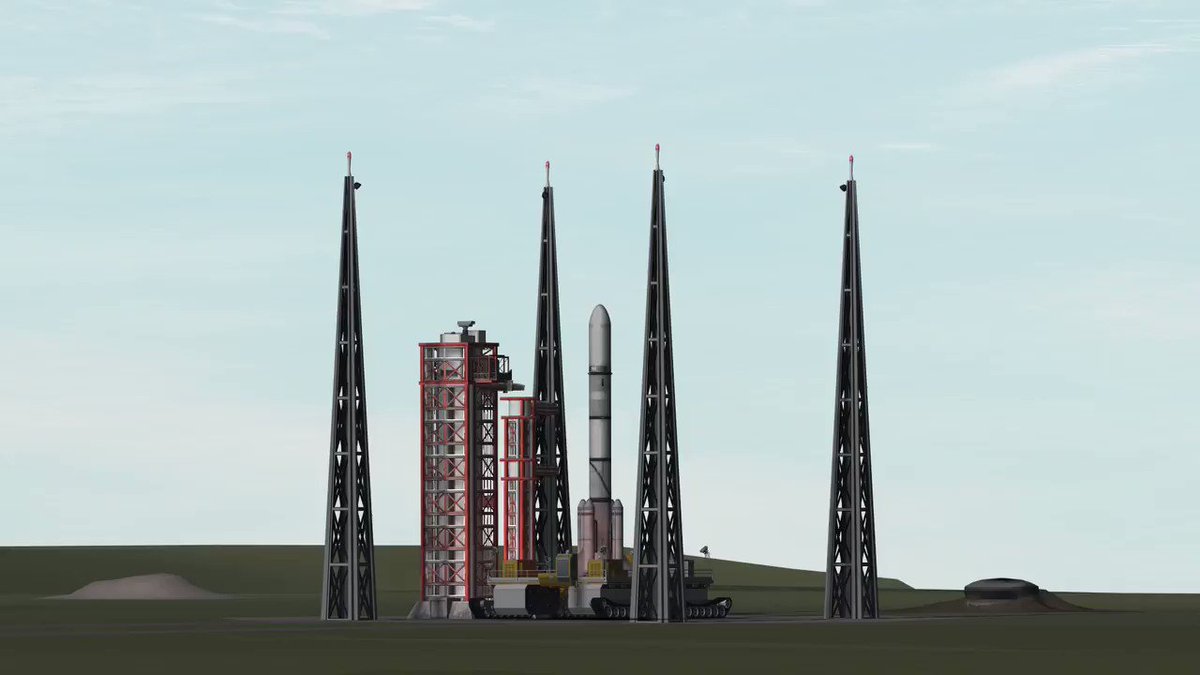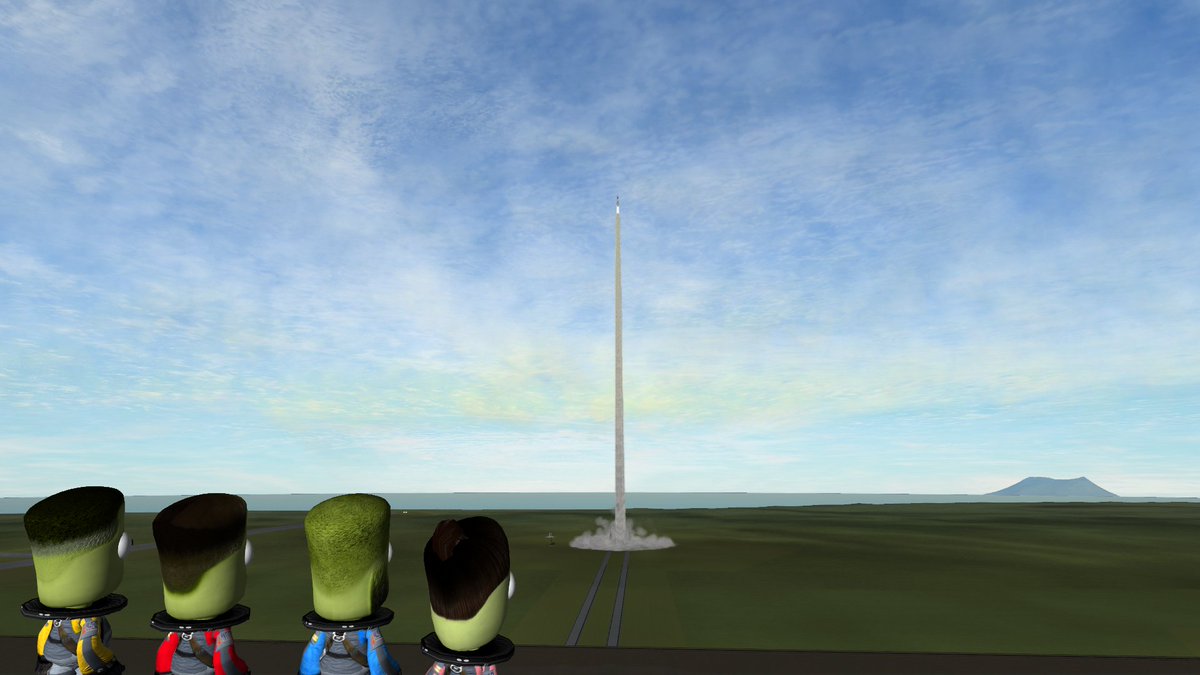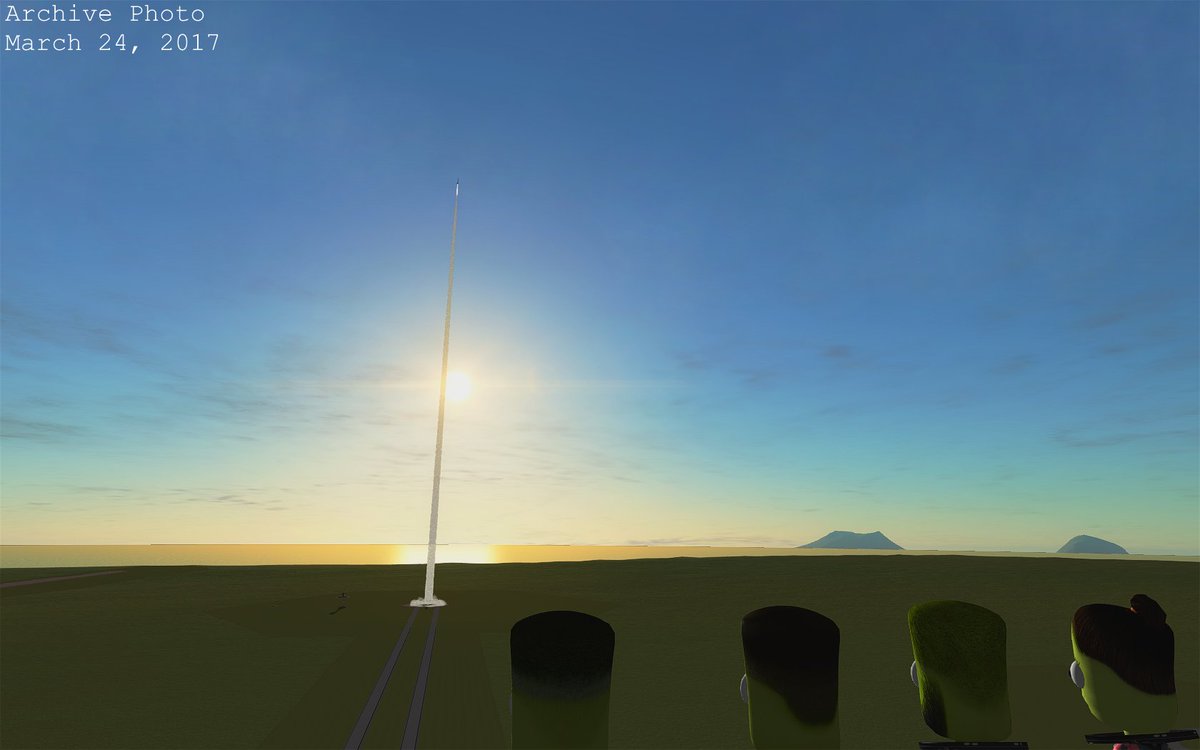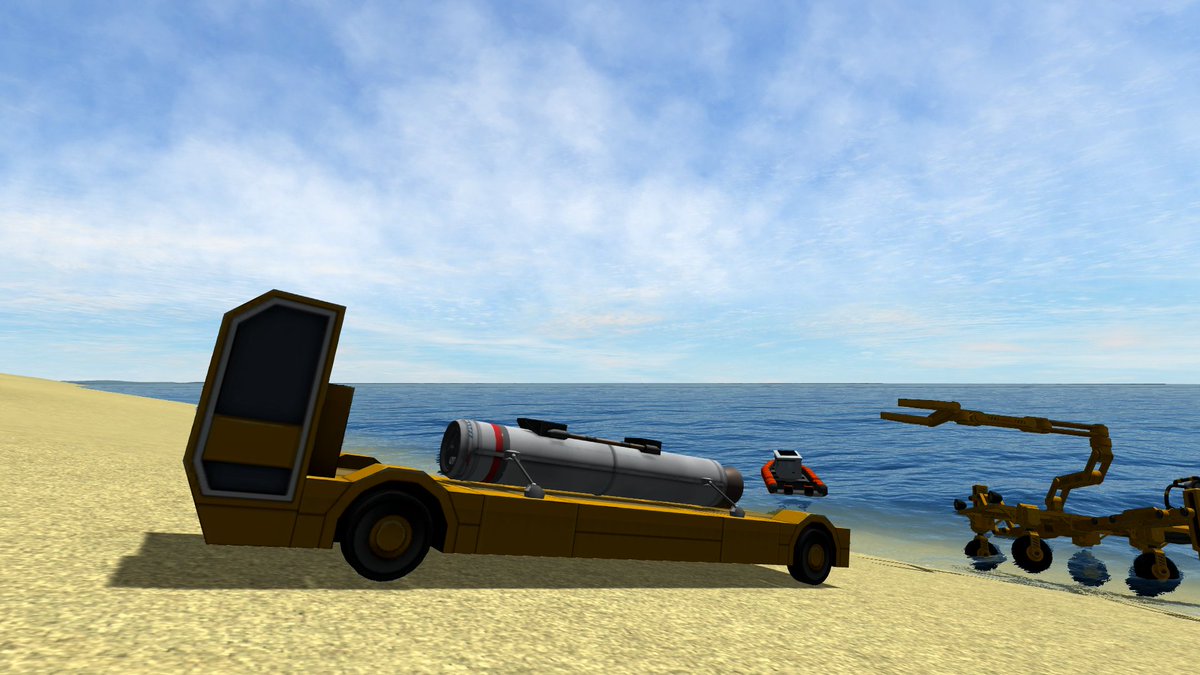|
Progenitor and Ascension Readying to Head to Space
The next launch is nearing and the Progeny Mk6 Block I rocket has finished its final inspection. Due to the new Ascension launch towers under construcion north of the pad It will launch from the field further north where we sent up Progeny Mk2s on eastward trajectories back in 2016. Launch time remains 13:49 UTC this coming Tuesday. In addition, the parts have arrived to begin construction on the Progeny Mk6 Block II rockets set to go up in mid-June. We’ll have more concrete details like dates and times after the first Ascension Mk1 launch but we can say that no payload instruments other than the radiation sensor will be on the first launch as we’re still not sure the air brakes will be able to get it back safely from well beyond 500km apokee.
Speaking of which, the Ascension Mk1 is continuing to come together nicely in the VAB, next week the 1t test weight will arrive and get its comms, data recorders, batteries and science instruments installed for the flight. We’ll also be attaching the radial parachutes to the lifter for our attempt at recovering the entire rocket for study. Launch time has been set – get ready for our first orbital attempt on 6/6 @ 20:17 UTC! Succeed or fail, parts are already being made ready for the following Mk1 that will go up sometime in early July.
Genesis Tests New Instruments
This week the Deuce flew two missions, starting with a survey flight out east for a contract during which a new camera was tested. Designed to be radially attached directly to a fuselage and streamlined against the airflow this “booster cam” as it is known will serve the purpose of allowing controllers to monitor payloads deployed off the roof of the aircraft. It will also be used for Ascension rockets to allow review of footage capturing the booster rockets falling away from the Mk1 Block II design or just monitoring the fins and control surfaces of the Block I.
Later in the week Jeb and Val flew another flight to test out the radially-attached mystery goo containment unit, which allows for the goo sample to be exposed directly to the atmosphere in flight. No issues were had during the mission, the unit properly opened and closed on command and remained firmly attached to the underbelly of the aircraft. The goo did not seem adversely affected by the flight up as high as 6km ASL.
KerBalloon Sends Up Two Probes
Also getting in on the mystery goo action was KerBalloon, which launched a probe carrying an inline goo containment unit, serving the same function as the radial instrument and allowing the sample onboard to be exposed or sealed on command. A smaller version is also available for use on future Progeny rockets. The goo came back from above the oxygen-rich layer of the atmosphere and scientists at first thought it was dead due to lack of oxygen but after a day back at sea level the goo slowly came out of some sort of stasis and seems to be healthy upon further study. Scientists are fascinated by this ability and wonder if it could even protect the goo while it is in space.
The second balloon release was an actual contract mission that took the crew out in UTVs for the first time in several months. They traversed the rough Highlands west of KSC to reach their release site and sent up a high-altitude balloon carrying material studies and meteorological instruments. The payload is currently being recovered for transport back to KSC and we’ll have a full report here later today upon their return.
Deep Space Network Milestones
Both ATN Central and the Arekibo Radio Observatory passed a critical milestone in their development this week. The Central observatory’s 10m telescope now has all 6 of its mirror segments complete, they will be shipped over to the site for installation starting next month. The Arekibo Radio Observatory has cleared through initial data testing of the comm lines that were installed both overland and undersea, 3 months of rigorous signal transmissions have come up with no major flaws. Both observatories remain on schedule to become fully operational next year. You can learn more about them and our DSN in this article.
Extremis Reconsiders Rejected Phase Two Trajectories
Head over to this news release for details, but the gist is that mission planners failed to take into account large radial/normal Δv components in the initial burn from Kerbin that inflated the total mission Δv cost. So some trajectories that didn’t make the cut for Phase Two because they used >3km/s of Δv could actually require less than that if the escape burn is performed from a more optimal orbit the vessel is launched into rather than the default 200km equatorial orbit used in the initial calculations.
ATN Database
The weekly update for the Asteroid Tracking Network database is available here, containing 1,982 asteroids and 7 updated with new observation data.
Celestial Snapshot of the Week
We’ve previously featured an image from Commander Valentina taken of Vall eclipsing the sun over Laythe while both dropped shadows on Jool, but this time an opportunity was available to capture Tylo eclipsing the sun over Laythe while they both dropped some shade on Jool. Problem was this event, which occurred multiple times over the course of about 3 weeks, happened mainly during conjunction when Jool was near or behind the sun. Either that or no scopes were properly positioned to capture it. The last possible chance was seized by the Ockr Observatory and even then they barely missed it as sunrise was just minutes away.
 From the Desk of Drew Kerman
From the Desk of Drew Kerman
Out of Character Behind the Scenes stuffWritten on 5/10/18
No notes on anything from this past week. Ops ran smooth, no problems with the aircraft flights. I even made a perfect landing in the Deuce finally! Still only at 2 weeks of lead time but doing my best to catch back up and make it 3.
Future storytelling
No spoilers, just a bit of rambling on how I see things working a few years down the line. The main issue I foresee is that missions out in space and to other planets won’t do well to be told in real-time via tweets like current atmospheric and sub-orbital missions are. Missions further outside the Kerbin system itself will also suffer from communication delays due to the distances involved. What I’m picturing right now are things like “crew diaries” where I post entries to the website that are told in first-person by the crew member and in this they talk about the mission and provide updates. It will be a more traditional storytelling technique similar to what some KSP role players are already doing on the forums and in YouTube series videos that act out events.
Current story arcs
In case you haven’t been paying attention, there’s actually a lot going on in the world besides what the KSA is doing directly. And you do have to pay attention because these arcs are advanced slowly with a tweet here and there and a mention here and there in the Ops Summaries. I’m just going to list a few examples off the top of my head:
- Monolithic stuff – major thread throughout the story so far, that will have far-reaching implications moving forward in several ways
- Monolith itself – crystal energy storage? What’s inside? Who left it here? What purpose was it designed for? Are there more? I have answers to these questions and more already but it’ll take years to get to them all
- Mystery goo – some interesting capabilities of the goo have already been revealed that could affect kerbals in the future
- Politics – right now still a backdrop, but could directly affect the KSA again in the future. Upcoming elections were mentioned for next year…
And more on the way… pay attention to what is said tomorrow! (the first tweet may not be obvious but is indeed a hint at future developments)








